
- Home
- Product information
- Vulcanization bonding product
Contact us
Phone :
+81 78 995-2341(Main Line)
FAX :
+81 78 995-2351
Email :
info@tkym-co.jp
Industrial rubber product
About Vulcanization bonding.
Vulcanization is a chemical reaction caused by heating raw rubber mixed with sulfur. If the technology is called vulcanization adhesive bonding between the dissimilar materials is performed at the same time as the vulcanization of rubber, the bonding interface with excellent durability by using a special bonding agent interfacial reaction is formed.
Takayama Ltd. adhesion technology boasts a competitive bonding technology.
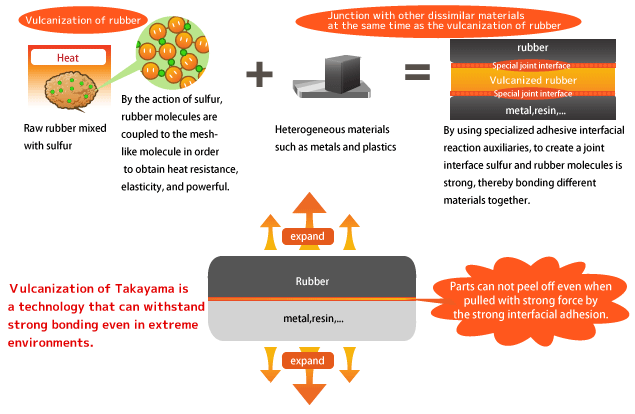

SUS304 and EPDM
6PA GF30% and NBR
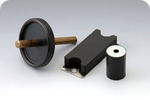
Brass and EPDM.
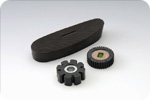
SPCC and NBR.
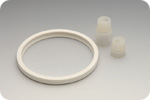
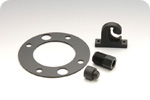
Punching NBR sheet goods
Natural rubber, also called India Rubber or caoutchouc, is an elastomer (an elastic hydrocarbon polymer) that was originally derived from latex, a milky colloid produced by some plants. The plants would be 'tapped', that is, an incision made into the bark of the tree and the sticky, milk colored latex sap collected and refined into a usable rubber. The purified form of natural rubber is the chemical polyisoprene, which can also be produced synthetically. Natural rubber is used extensively in many applications and products, as is synthetic rubber. It is normally very stretchy and flexible and extremely waterproof.
| Property | Flammability | Self-extinguishing |
| Have physical properties. | easy | None |
Nitrile butadiene rubber (NBR) is a family of unsaturated copolymers of 2-propenenitrile and various butadiene monomers (1,2-butadiene and 1,3-butadiene). Although its physical and chemical properties vary depending on the polymer’s composition of nitrile, this form of synthetic rubber is generally resistant to oil, fuel, and other chemicals (the more nitrile within the polymer, the higher the resistance to oils but the lower the flexibility of the material).
It is used in the automotive and aeronautical industry to make fuel and oil handling hoses, seals, and grommets. It is used in the nuclear industry to make protective gloves.
| Property | Flammability | Self-extinguishing |
| Have oil resistance. | Easy | None |
Neoprene or polychloroprene is a family of synthetic rubbers that are produced by polymerization of chloroprene. Neoprene in general has good chemical stability, and maintains flexibility over a wide temperature range. It is used in a wide variety of applications, such as laptop sleeves, orthopedic braces (wrist, knee, etc.), electrical insulation, liquid and sheet applied elastomeric membranes or flashings, and car fan belts.
A foamed neoprene containing gas cells is used as an insulation material, most notably in wetsuits. Foamed neoprene is also used in other insulation and shock-protection (packing) applications.
| Property | Flammability | Self-extinguishing |
| Have the heat resistance. | Little hard | True |
Styrene-butadiene or styrene-butadiene rubber (SBR) is a synthetic rubber copolymer consisting of styrene and butadiene. It has good abrasion resistance and good aging stability when protected by additives, and is widely used in car tires, where it may be blended with natural rubber. It was originally developed prior to World War II in Germany,[1]. Industrial manufacture began during World War 2, where it was used extensively by the USA to replace the Far-East natural rubber supplies captured by the Japanese.
| Property | Flammability | Self-extinguishing |
| Have the rub resistance. | Easy | None |
Butyl rubber is a synthetic rubber, a copolymer of isobutylene with isoprene. The abbreviation IIR stands for Isobutylene Isoprene Rubber.
Butyl rubber has excellent impermeability, and the long polyisobutylene segments of its polymer chains give it good flex properties.
A synthetic rubber, or elastomer, butyl rubber is impermeable to air and used in many applications requiring an airtight rubber.
| Property | Flammability | Self-extinguishing |
| Low gas permeability, is excellent in acid resistance. | Easy | None |
Polyurethanes are used in the manufacture of flexible, high-resilience foam seating; rigid foam insulation panels and gaskets; tires; automotive suspension bushings; electrical potting compounds; high performance adhesives; synthetic fibers (e.g. Spandex); carpet underlay; and hard-plastic parts (i.e. for electronic instruments). Polyurethane is also used for the manufacture of hoses and skateboard wheels as it combines the best properties of both rubber and plastic.
| Property | Flammability | Self-extinguishing |
| Has excellent wear resistance in mechanical strength. | Easy | None |
Ethylene propylene rubber (EPR) is an insulation used for high voltage cables. It has improved thermal characteristics over more traditional cables, such as cross-linked polyethylene, enabling a smaller cross sectional area for the same load carrying capacity. The cable is flexible and suited to applications where regular cable movement is required such as in the mining industry and for temporary installations.
| Property | Flammability | Self-extinguishing |
| Has excellent heat resistance and oxidation resistance. | Easy | None |
A fluoroelastomer is a special purpose fluorocarbon-based synthetic rubber. It has wide chemical resistance and superior performance, especially in high temperature application in different media.
| Property | Flammability | Self-extinguishing |
| Has excellent heat resistance and chemical resistance. | Hard | True |
Silicone rubbers are widely used in industry, and there are multiple formulations. Silicone rubbers are often one- or two-part polymers, and may contain fillers to improve properties or reduce cost. Silicone rubber is generally non-reactive, stable, and resistant to extreme environments and temperatures from −55 °C to +300 °C while still maintaining its useful properties. Due to these properties and its ease of manufacturing and shaping, silicone rubber can be found in a wide variety of products, including: automotive applications; cooking, baking, and food storage products; apparel such as undergarments, sportswear, and footwear; electronics; medical devices and implants; and in home repair and hardware with products such as silicone sealants.
| Property | Flammability | Self-extinguishing |
| Have excellent heat resistance and cold resistance. | Easy | None |
